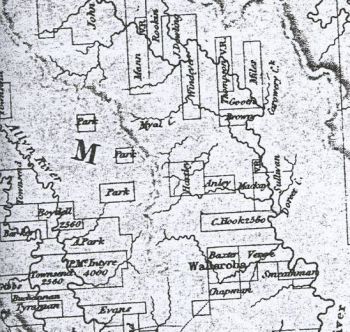John Mann - Settler
Munni - Map 3
John Mann was born in Broadhempston, Devon, England in 1808, son of William Mann and Elizabeth Furneaux. According to later gaol records he first arrived in the colony on the Caroline in 1829.
His brother Samuel Furneax Mann and family arrived on the Caroline from London in 1833. Another shipping record has John Mann arriving in Sydney from New Zealand on the Caroline in 1834.
Land Grant
A Land Grant of 1920 acres was promised to John Mann on 11th November 1828 and possession authorised as a primary grant 13th October 1829 in lieu of the like quantity authorised under same promise 16th May 1829.John Mann selected land in the Upper Williams River district and named his selection Munni. [1] In the 1828 Census taken in November 1828 there were 3 horses on the property; 400 head of cattle and 240 sheep. A slab hut had been constructed as well.

Assigned Convict Servants
Convicts assigned to John Mann in the 1830's included:-
Andrew Caldwell who arrived on the Countess Harcourt 1827 (whitesmith)
-
Benjamin Redwood who arrived on the Portland 1832 (Potboy)
-
Finley Ferguson who arrived on the Marquis of Huntley 1830 (Shearer and Shepherd)
Accusation of Cattle Stealing
In 1835 John Mann was accused of cattle stealing by Magistrate John Wighton who was Director of the Society of Protection of livestock. On 20 February 1835 John Mann was thrown into Newcastle gaol and from there sent to Sydney Gaol to be tried at the Supreme Court. The ownership of his land at this time was transferred to his brother Samuel F. Mann.In March 1836 John Mann accused John Wighton of delaying the trial and of attempting to influence witnesses and when the case came before Justice Therry in March 1836 he remarked that he made
a criminal information with the greatest diffidence as the facts sworn to in the affidavit appeared to be of the most extraordinary character. Here he read the affidavit of the complainant, John Mann, which stated that he was committed in April 1835 by John Wighton to take his trial for cattle stealing; that in May he brought down 18 witnesses from the Hunter, at an expense of £140 ; that owing to the influence of Mr. Wighton his trial was not brought on, and that Wighton went to the gaol at Sydney, and told a man named Morrissey that if he would give such evidence as would convict Mann he would give him £100 ; and further, that Morrissey and Lemon one from an iron gang, and the other from the hulk, were put into one cell for 11 nights for the purpose of gtting up a story against Mann and that through the delays he had been put to his defence cost him upwards of five hundred pounds.Nothing further came from these charges and counter charges as John Wighton although only about 26 years of age, passed away in May 1836.
John Mann's brother Samuel Furneaux Mann was employed as a grocer in Sydney. Both he and John Mann came into difficulty in the financial downturn of the early 1840's. [3]
In June 1844 one thousand and twenty acres were offered for sale. This land was described as a 1828 grant to John Mann in lieu of a former selection to the name of Samuel Furneaux Mann. [2]
The Hunter Water Registry has the following information....
According to the Lands Titles Office records, the property was sold to John Hughes in 1841, and in 1843 Hughes sold it on to Joseph Myatt. Munni then passed to Edward Newtown, before Newtown sold the land to William Alexander Smith in 1873. Another record however, indicates that a gentleman by the name of Edwin Smith, who had settled nearby up the Sheep Station Creek after quitting his parents' property, Bandon Grove, bought the adjoining land on which Munni House is situated sometime after 1868.[5]
The land was purchased by the Hunter Water Corporation for use as part of the Tillegra Dam proposal.
References
[1]. Government Gazette 9 August 1837[2]. Colonial Observer 20 June 1844
[3]. Sydney Gazette 6 August 1842
[4]. Ancestry.com Gaol Description and Entrance Books, Newcastle Gaol. State Archives NSW; Roll: 136
↑
